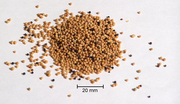
Mustard seed
Background Information
This wikipedia selection has been chosen by volunteers helping SOS Children from Wikipedia for this Wikipedia Selection for schools. Visit the SOS Children website at http://www.soschildren.org/
| Nutritional value per 100 g (3.5 oz) | |
|---|---|
| Energy | 1,964 kJ (469 kcal) |
| Carbohydrates | 34.94 g |
| - Sugars | 6.79 g |
| - Dietary fibre | 14.7 g |
| Fat | 28.76 g |
| - saturated | 1.46 g |
| - monounsaturated | 19.83 g |
| - polyunsaturated | 5.39 g |
| Protein | 24.94 g |
| Water | 6.86 g |
| Vitamin A equiv. | 3 μg (0%) |
| Thiamine (vit. B1) | 0.543 mg (47%) |
| Riboflavin (vit. B2) | 0.381 mg (32%) |
| Niacin (vit. B3) | 7.890 mg (53%) |
| Vitamin B6 | 0.43 mg (33%) |
| Folate (vit. B9) | 76 μg (19%) |
| Vitamin B12 | 0 μg (0%) |
| Vitamin C | 3 mg (4%) |
| Vitamin E | 2.89 mg (19%) |
| Vitamin K | 5.4 μg (5%) |
| Calcium | 521 mg (52%) |
| Iron | 9.98 mg (77%) |
| Magnesium | 298 mg (84%) |
| Phosphorus | 841 mg (120%) |
| Potassium | 682 mg (15%) |
| Sodium | 5 mg (0%) |
| Zinc | 5.7 mg (60%) |
| Percentages are relative to US recommendations for adults. Source: USDA Nutrient Database |
|
Mustard seeds are the proverbially small seeds of the various mustard plants. The seeds are about 1 mm in diameter, and may be colored from yellowish white to black. They are important spices in many regional cuisines. The seeds can come from three different plants: black mustard ( B. nigra), brown Indian mustard ( B. juncea), and white or yellow mustard ( B. hirta/Sinapis alba).
In the Indian subcontinent they are often used whole, and are quickly fried in oil until they pop to impart a flavor to the oil.
History
The French have used mustard seeds as a spice since 800 AD, and it was amongst spices taken by the Spanish on explorations throughout the 1400s. Pope John XXII was particularly fond of mustard, and created a new position in the Vatican, 'grand moutardier du pape', or 'mustard maker to the pope'.
Cultivation
Mustard seeds generally take 3–10 days to germinate if placed under the proper conditions, which include a cold atmosphere and relatively moist soil. Mustard seeds grow into shrubs, not trees.
Mustard grows well in temperate regions. Major producers of mustard seeds include Hungary, Great Britain, India, Canada (90%) and the United States. Brown and black mustard seeds return higher yields than their yellow counterparts.
Preparation
Mustard oil can be extracted from the seeds. The seeds, particularly the white ones, can also be ground into flour, and mixed to a thick paste with a little water to make the condiment mustard. The ground mustard powder is usually mixed with ordinary flour to reduce the strength of the resulting condiment.
Other ingredients can be used to mix mustard, for example, sugar, honey, vinegar, wine, or milk.
When initially mixed the sauce is mild in flavor, but it develops in time. Strong mustard has a very powerful (and painful) effect on the nasal membranes if eaten carelessly.
The whole seeds can be soaked in liquid before grinding to create whole grain mustard.
It is possible to buy prepared mustard in many places.

